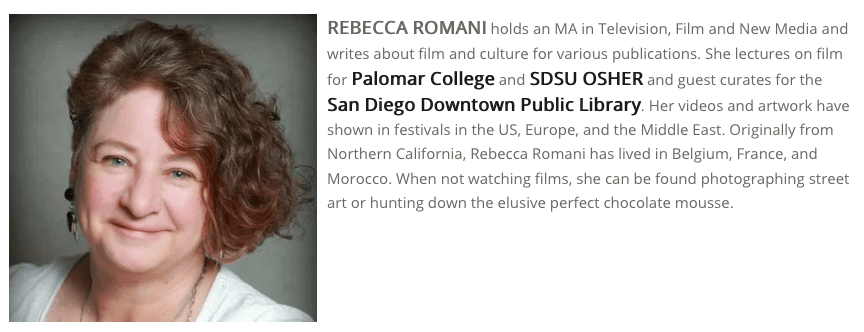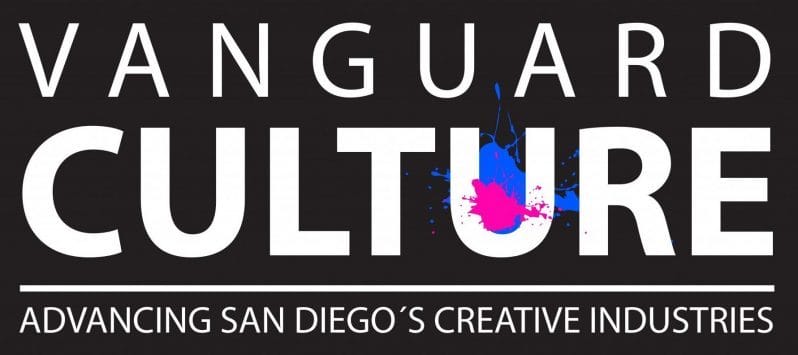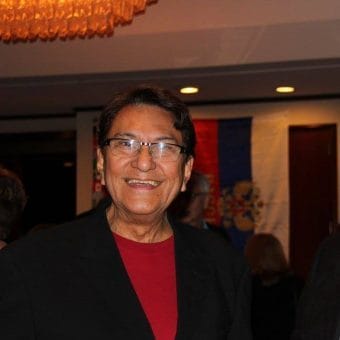An Iconic Presence in San Diego Arts, Larry Baza Passes at 76
By Rebecca Romani
March 1, 2021
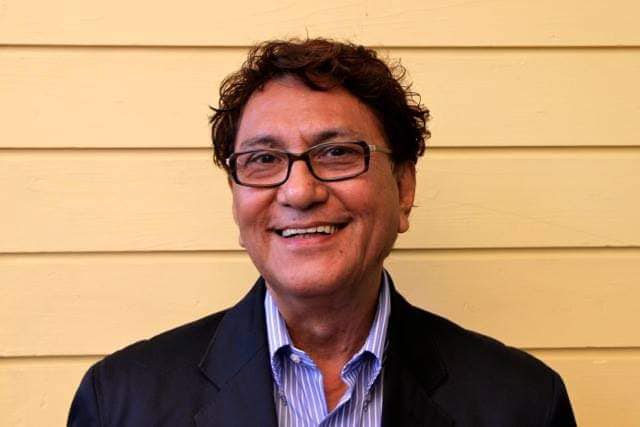
The news spread like a raging wildfire and mere hours later, messages were popping up on social media like wildflowers after the fires have passed. One of San Diego’s truly great community arts leaders, Larry T. Baza passed away from COVID on Feb. 20, just days shy of his 77 birthday and social media buzzed with condolences, memories, and outpourings of grief and loss, love and gratitude.
Alan Ziter, executive director of the NTC Foundation, called him a “San Diego treasure,” while remembering more than 30 years of shared arts experiences.
“He was humble and oddly energetic, like he couldn’t wait for the next changes in the arts horizon,” said Lara Katheryn of Rising Arts Leaders, “You knew he could do anything and he made you feel like you could, too.”
“The arts community lost a titan and we are deeply grateful for his many, many contributions to the arts and the greater San Diego community” stated Susanna Peredo Swap, Executive Director of Vanguard Culture.
“Larry was such a multifaceted person that it comes into sharp relief seeing the love and support expressed from so many different areas, the Arts Community, the Chicano Community, the LGBTQ + community, family, friends, and many more,” said Patricio Chavez, a Professor of Photography and former Visual Arts Coordinator at the Centro Cultural de la Raza.
In the over the 40+ years Baza spent in community service and the arts, there are few artists and arts organizations in the San Diego region that he did not touch. In addition, his influence on the arts in San Diego, in particular Chicano art, and his dedication to promoting them spread far beyond San Diego to the rest of California, even passing over the borders of the US. His was a discernment for potential that launched up-and-coming artists, created outstanding collections, and set special programming for the arts in motion.
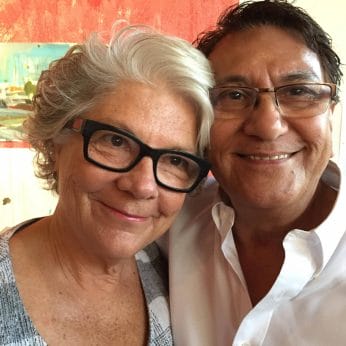
“Larry Baza was an artist—a theater artist. He lived a life that in itself was a work of art,” said Cindy Zimmerman, a local artist and a strong presence in the arts community in her own right, in an email. “The collaborative service he performed, his visionary discernment, and his capacity for connection inspired and nurtured generations of artists and activists.”
Baza was, in a sense, a rara avis. A San Diego native son, Baza was born in 1944, near the end of WWII, to Tito Cepeda Baza, from Guam, who served in the U.S. Navy, and Hortencia Celaya Baza, a third-generation Mexican American.
But Baza was also born into times of change. Born one year after the Zoot Suit Riots in Los Angeles, Baza learned early that being Latino in Southern California, especially in a military town on the border, was not easy. In interviews, Baza talked about how young Latinos would struggle to maintain their culture and the language only to have it come under siege time and time again.
By the time Baza went to college in San Diego, the Civil Rights movement was rising, the Chicano Movement and Gay Rights on the horizon. The inspiration he took from those movements, in addition to his own lived experiences, compelled him towards community service, and a sense of inclusivity that become his hallmark.
“Larry always credited both his parents for inspiring his commitment to public service,” Tom Noel, Baza’s husband and partner of the Noel-Baza Fine Arts Gallery, wrote in an email. “His mother was instrumental in implementing one of the first Head Start Programs in San Diego. Tito and Tencha were incredibly active and generous in their church, their ethnic communities and they instilled in all of their sons the importance of public service.”
Alessandra Moctezuma, Art Professor and head of the Mesa College Art Gallery said of Baza in a Facebook post, “he was of a generation of young people in the late 60s that were engaged in civil rights and I can see how this was such an important part of his life.” Moctezuma called Baza “an inspiration to stay the course” for her as a Mexican American artist for whom the personal is part of the struggle, and she also recalled Baza as a major supporter of the gallery who purchased student works and introduced her to other artists that she would then show.
Many have noted Baza’s deep commitment to the arts as catalyst for change. “He was such a believer in the power the arts have to transform lives, as his life was an example,” said Russ Sperling, director of the Visual Arts Performing Department (VAPA), remembering Baza’s contributions as the first president of the VAPA Foundation, an entity devoted to enhancing the quality and access to arts education in the San Diego Unified School District.
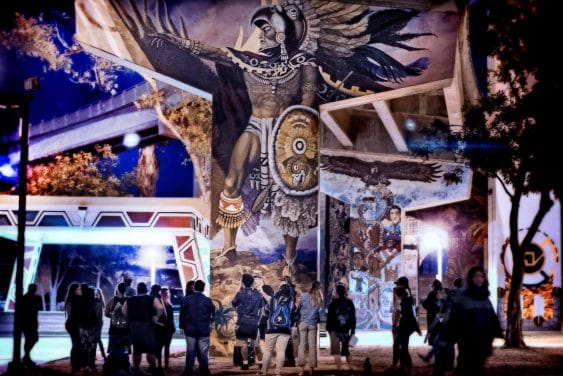
An early champion of the Chicano movement and LGBTQ rights, Baza’s faith in the power of the arts to provoke change was the lynch pin of everything he did. Baza supported the Farmworker’s grape boycott and donated to Luis Valdez’s ground-breaking El Teatro Campesino. Later, he was one of the first supporters of San Diego’s Chicano Park, now a national landmark, and of the Centro Cultural de la Raza in Balboa Park. As part of the first Artists for AIDS Assistance Fund Benefit (1987), Baza made a point to the L.A. Times that support for such causes needed to be broad-based, noting at the time that while many of the performing artists were LGBTQ, the audiences were largely not. “I want our own audiences there,” he said, of those he hoped would help the Benefit.
As a long-time supporter of LGBTQ rights, Baza brought his passion for inclusivity to his role with San Diego Pride, eventually co-chairing it with Vertez Burks in 1992, the first time the event was led by two people of color. He brought that same vision to his role as president of the San Diego Democrats for Equality, earning high praise as a “champion of progress.” His parents’ practice of service to community further inspired Baza to serve on a number of boards, including The San Diego Community Foundation, the National Endowment for the Arts (NEA) and chaired the California Arts Council.
Robert Sanchez, a well-known local artist and Professor of Fine Arts at Mesa College, recalled meeting Baza at the San Diego Community Arts Project in the late 1970’s. “He hired me into the family of creative workers. This was my first job in the arts upon arriving in San Diego in January of 1978.”
Community Arts, as it was known, was a vibrant collection of diverse projects like an art gallery, a coffee shop, dance studios, and a theatre space, located downtown. It operated, WPA-style, on a generous grant from the Comprehensive Employment Training Act. Baza was associate director from 1978-1982 and hired a wide variety of artists.
“I can state unequivocally that Larry exhibited the character of all powerful beings. He was humble, caring, and filled with a magnificent sense of humor. His laughter was infectious,” said Sanchez
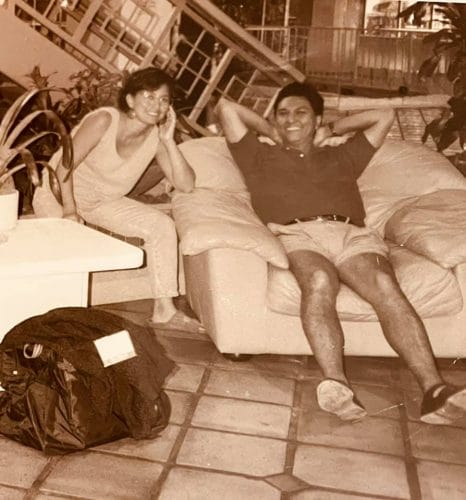
Baza would go on to be a part of such cutting-edge arts groups such as Sushi Gallery (Associate Director, 1985-87), started by Lynn Schuette, and to helm the Centro Cultural de la Raza, aided by Patricio Chavez and Eloise de Leon, performance curator, during the 1990s. Under Baza’s guidance, the Centro became a rising powerhouse, supporting significant Chicano artists like Mario Torero, Victor Ochoa, and Richard Lou, as well as Native American artist James Luna. It was also an incubator for up-and-coming artists and groups like The Taco Shop Poets, the Border Arts Workshop, and Las Comadres.
“It was an incredible and challenging time,’’ Chavez wrote in an email.
“Pete Wilson was Governor of California, and Reagan’s presidency had just ended. The groundwork for what’s happened more recently with the Trump Presidency was just being laid out. The mishandling of the AIDS epidemic, the extremely racist “Light up the Border” Anti-Mexican activism, Propositions 187 and 184, hate crimes, etc.
Larry’s collaboration and leadership helped guide us through this cauldron of fear and we flourished creatively.”
Over the approximately 10 years Baza was Executive Director, the Centro became a major player in cross-border arts exchanges and collaborations with other arts museums.
“We even represented the U.S. at the Istanbul Biennale (1992) and sent works to overseas exhibits” as well as hosting numerous exhibitions and performances, said Chavez.
Robert Pincus, an arts critic and former arts writer for the San Diego Union Tribune, agrees.
Pincus, who wrote extensively about the Centro, remembers Baza as “generous of spirit, saying that he “showed vision.” Pincus credits Baza with bringing a second wave of energy to the cultural center. “He was a good conversationalist,” Pincus says. “You always walked away inspired.”

Ethan Van Thillo also remembers Baza’s enthusiasm and faith in 1994 for a scrappy little student film festival. In an email, Van Thillo said “Larry Baza welcomed us with open arms when we brought the first edition of the San Diego Latino Film Festival to the Centro Cultural de la Raza in 1994. Since then, he was always such an important supporter and mentor (via his own gallery, the City of San Diego Commission for Arts & Culture and California Arts Council) of our film festival; and our non-profit, Media Arts Center San Diego.”
The little festival grew into one of the largest and oldest Latino Film Festivals in the United States, and this year, celebrates its 28th year, with an excellent digital line-up.
Baza’s vision carried over into his projects post-Centro. “As a colleague, he taught that we were “bridgers,” an idea now embodied in the ideas of “intersectionality” and “allyship,” said Zimmerman.
One gallery owner and curator, Patric Stillman of The Studio Door remembering him as someone who “provided a path of community engagement that I hope to emulate in my own work.”
Jessica Hanson York, of the Mingei Museum in Balboa Park, remembers Baza as “a bright, positive spirit, a relentless advocate and a leader for so many organizations.”
Post-Centro, Baza took that spirit and channeled it into the Public Art Committee of the San Diego’s Arts and Culture Commission (SDACC). He was also the first Latinx chair of SDACC, as well as the first Latinx Chair of the California Arts Council (CAC).
In an interview at the time he was appointed to the CAC by then Assembly Speaker Tony Atkins, Baza said, “My work in the arts has been driven by the belief that the arts have the power to spur the growth of creative and questioning citizens, build safe communities and contribute to a healthy and civilized society.”
Baza’s belief in the arts as an integral part of society, led him to mentor various artists and arts administrators both personally and through his various affiliations, including the Noel-Baza Gallery on India Street that he ran with his husband of 37 years, Tom Noel.
One such artist, Teresa Mill, a local painter, called Baza an “incandescent presence.” Mill, who had received a grant through the Public Arts Advisory council to paint a mural for a day shelter for homeless women, credits Baza with shepherding her project through the process and helping smooth the way to successfully completing the mural.
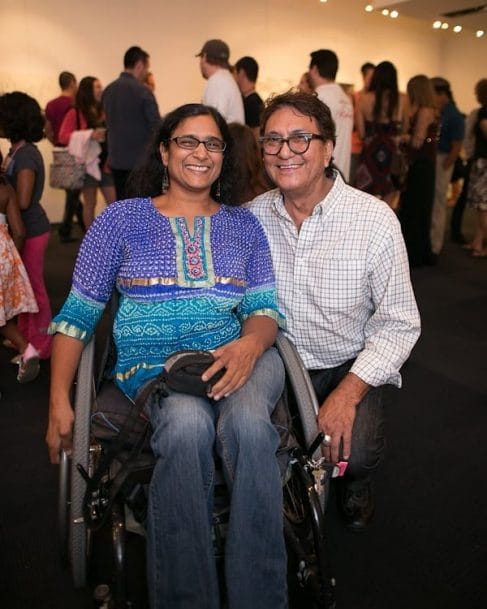
Photo credit: Robin Brailsford
“Larry gave me my first prize,” said Bhavna Mehta, who won First Prize at the juried 5th Annual Dia de la Mujer (Day of the woman) at the Front in San Ysidro (2012). Mehta, who has garnered considerable attention both locally and nationally, had her first solo show, a stunning exhibit, at the Noel-Baza gallery, effectively launching a meteoric rise as a cut paper and embroidery artist.
In a post on Facebook, Mehta paid tribute to Baza ,saying, “Larry exemplified a keen sense of pride in his work and his interests and encouraged me to persevere.”
Leticia Gomez Franco also credits Baza with encouraging her in her development as an arts administrator. In addition to curating a number of impressive exhibits in the San Diego region, Gomez Franco has worked with The Front in San Ysidro, the New Americans Museum, as well as the San Diego Commission for the Arts and, most recently, the Balboa Art Conservation Center.
“Larry did so much to pave the way for us,” said Gomez Franco in a Facebook post to Vanguard Culture. “As a Xicana arts administrator, Larry had a presence in every single destination my journey led to and when I got there, he’d give me this look like “it’s about time you got here, mujer, now go ruffle some feathers!”
Baza’s loss is also keenly felt by the San Diego Art Prize (SDAP), whose committee he joined in 2020. Patricia Frischer, coordinator and founder of the Visual Arts Network which oversees the prize, called Baza one of the most beloved art supporters in the region in an email, adding” (h)e was politically astute without being a politician. I believe that is why he had the respect of so many people.”
“You always knew how he (Larry Baza) felt about an issue and yet he was compassionate, fair and a total pleasure to work with,” said Chi Essary, an independent curator, Vanguard Culture board member and member of the San Diego Art Prize Committee. In a statement release by Frischer, the committee is dedicating this year’s prize to Baza. “All of us on the committee are just crushed this beautiful soul is no longer with us and have decided to dedicate this year’s SD Art Prize to his memory.”
Baza’s passing leaves a rich legacy of arts and advocacy that has made an indelible mark on the region.
The art critic Robert Pincus called Baza a model for anyone wanting to work in the arts and an inspiration to people for his unselfish enthusiasm and belief that one should do good for each other.

Photo: Suzanne Hawkins
In Reflecting on Baza, Lynn Schuette commented, “Larry taught us to be present, to use a contemporary term, to represent ourselves and our communities, to serve (something his father taught him) these communities and to recognize our multi-dimensionality.”
“Now we can continue our lives as works of art, for ourselves and on his behalf. Larry’s absence will become a portal to illuminate the dark places where we sometimes find ourselves. He will always be with us, just playing a different role, added Zimmerman.
Baza is survived by, Tom Noel, his husband of 37 years; brothers Ronald and Mark Baza; nieces Kimberlee Baza Petersen and Carolyn Baza of Lakeside, Ibette Baza of San Diego; nephew Marc Baza of Fallbrook; and numerous grandnieces and grandnephews.
A private family service will be held. The family requests that in lieu of flowers, contributions to the SD Food Bank are most appropriate at this time. When it’s possible for a large number of people to gather a community celebration will be held.
Vanguard Culture’s next Creative Industry Roundtable on Monday, April 26th at noon, will be in his honor. Save the date for a gathering of San Diego’s arts community, in celebration of Larry T. Baza’s life and work. REGISTER TO ATTEND HERE.

